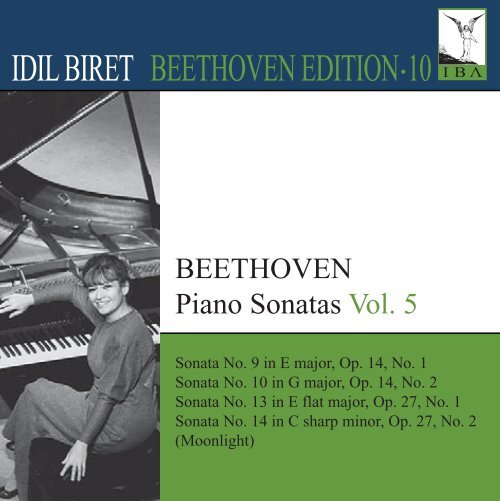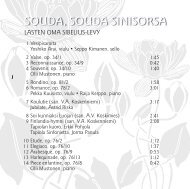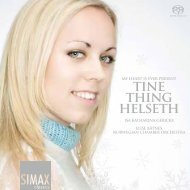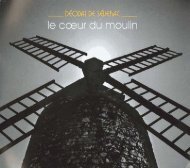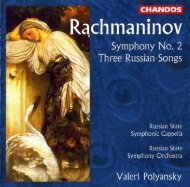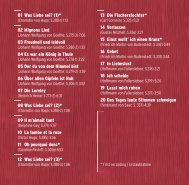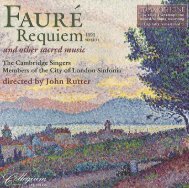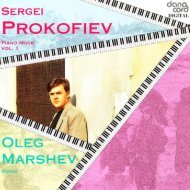IDIL BIRET BEETHOVEN EDITION.10
IDIL BIRET BEETHOVEN EDITION.10
IDIL BIRET BEETHOVEN EDITION.10
You also want an ePaper? Increase the reach of your titles
YUMPU automatically turns print PDFs into web optimized ePapers that Google loves.
<strong>IDIL</strong> <strong>BIRET</strong> <strong>BEETHOVEN</strong> <strong>EDITION.10</strong><br />
<strong>BEETHOVEN</strong><br />
Piano Sonatas Vol. 5<br />
Sonata No. 9 in E major, Op. 14, No. 1<br />
Sonata No. 10 in G major, Op. 14, No. 2<br />
Sonata No. 13 in E flat major, Op. 27, No. 1<br />
Sonata No. 14 in C sharp minor, Op. 27, No. 2<br />
(Moonlight)
Ludwig van Beethoven (1770-1827)<br />
Piano Sonatas, Volume 5<br />
Sonata No. 9 in E major, Op. 14, No. 1<br />
Sonata No. 10 in G major, Op. 14, No. 2<br />
Sonata No. 13 in E flat major, Op. 27, No. 1 (Sonata quasi una fantasia)<br />
Sonata No. 14 in C sharp minor, Op. 27, No. 2 (Sonata quasi una fantasia) (Moonlight)<br />
Beethoven’s two Sonatas Op. 14, along with the Sonata for Horn and Piano of 1801, were dedicated<br />
to Baroness Josefine von Braun, wife of the Baron Peter, a successful businessman and lessee of the<br />
National-Theater, and afterwards of the Theater-an-der-Wien. Although this was an early association of<br />
the composer’s which eventually led to an invitation to write an opera, we do not really know whether he<br />
enjoyed a strong social footing with either husband or wife. Mollo was the name of the publishing house;<br />
the announcement date 21st December, 1799.<br />
Only of the Sonata No. 9 in E major, Op. 14, No. 1, do copious sketches appear in Nottebohm’s<br />
publication Zweite Beethoveniana that also includes the Sonata for Violin and Piano, Op. 12, No. 3, and<br />
the Piano Concerto in B flat. The composer adapted it as a string quartet, transposing it up one semitone<br />
to accommodate the cello part. Essentially a lyrical work, this gentle sonata at first appears a somewhat<br />
introspective work, rather unassuming in its easy-sounding fluency and harmless initial statement with<br />
repeat. Yet the second subject of the Allegro, with right-hand octaves over those favourite left-hand<br />
semiquaver groupings, raises the temperature while leading back to the main subject, played forte to<br />
rising scale accompaniment. Apart from various sforzandi emphases in sudden chord modulations, the<br />
ending is peaceful.<br />
The Allegretto second movement with its three-note phrase (E minor) and unexpected G major reply<br />
insertion, has an almost foresighted Schubertian quality, particularly in the ‘decorated’ restatement, but<br />
the maggiore c major central part transforms pessimistic feelings into regal assertiveness. Beethoven’s<br />
added coda, following the repeat, is plaintively simple.<br />
In contrast, the final Rondo is roguishly playful, the three-note quavers in the left hand providing a<br />
boisterous gait to right-hand octaves. The reply figure with downward spirals of sixteenth notes<br />
(semiquavers) – then in contrary motion – has the rustic flavour of Austrian peasants playing practical<br />
jokes on ignorant foreigners. Beethoven, of course, adds to everyone’s confusion by interchanging<br />
hands in the matter of quavers and octaves, and altering the key rapidly at the same time. A scale up the<br />
keyboard temporarily readjusts normality in the return of the main subject, then the music runs amock in
successions of hammered octaves, sforzandi, suddenly switching to offhand charm at the close.<br />
Schindler provides a visionary account of Beethoven’s playing where ‘the hearer could fancy he actually<br />
beheld the lover in his living form, and heard him apostrophizing his obdurate mistress’. There is a<br />
good deal of evident ‘persuasiveness’ in the offbeat six-note phrase that begins the Allegro of Sonata<br />
No. 10 in G major, Op. 14, No. 2. An insistent rocking motion pervades the whole movement, a feeling<br />
of song-like ardency in wide-spaced intervals of octaves and tenths stretching the hero’s attempts to<br />
serenade his sweetheart in a constant stream of legato melody that allows for no interruptions – one has<br />
the strong suspicion that this all occurs on the waters of a lake during a bright summer afternoon. At some<br />
point during the second G minor subject (overshadowed by E flat), things go slightly out of control and<br />
attempts to right matters become rather strenuous. Overall invention however, is at its peak.<br />
The Andante (La prima parte senza replica), Alla breve and in C major, the ‘male’ rôle in mid register, the<br />
‘female’ reply higher up, is a stilted, mock-serious conversation piece. Together, there is a descant quality<br />
to the writing, complete with holy intentions. Beethoven transforms his main theme into decorative<br />
semiquaver three-note groups and flourishes, reverting to a straightforward ending with a startling octave<br />
chord.<br />
The Scherzo, marked Allegro assai, is a kind of ‘catch me, if you can’, with fleeting scampers up the<br />
scale, then tiny, playful quick retorts with both hands actively involved. Altogether, some of the most<br />
entrancing music penned, and pre-Rossini.<br />
Beethoven designated both his Sonatas, Op. 27, with the subtitle Sonata quasi una fantasia. Thayer refers<br />
to this as “a departure from the customary structure”, while Denis Matthews, more cleverly, sees this as<br />
“disarming criticism of their unorthodox procedures”. Two occurrences in the years 1800-1, one actual<br />
and the other delayed, also surround the conception and completion of these and other works by the<br />
composer. In the 1790s Viennese pianos were almost entirely made of wood; only the strings and tuning<br />
pins were metal. Their range was five octaves, so that all of Haydn’s and Mozart’s compositions for<br />
pianoforte, as well as Beethoven’s up to his Third Concerto, were confined to the restricted compass. An<br />
advertisement in 1799 (not Viennese) offered an extension up to six octaves, while the firm of Streicher<br />
made certain refinements to J. Andreas Stein’s escapement. The new standard for pianos made in Vienna<br />
(‘bouncing’) with their shallow key-fall and small hammers covered with leather, became known as<br />
the “Vienna action”. The tone was light, and long, thin bass strings were used to compensate for any<br />
weaknesses in the lower registers. At the turn of the century Matthias Müller, the Vienna piano-maker,<br />
announced his new upright pianoforte, set up on its tail on the floor in a rectangular case. It would stand<br />
about 5 feet 2 inches, and instead of the gap in the sounding-board for the hammers to strike the strings
from behind, he devised a down-striking action. Unfortunately he was years ahead of the times, and<br />
limited production costs made the price too high for sufficient people to become interested. The idea did<br />
not catch on finally until years later, following the designation of his model with the unpronounceable<br />
title Ditalleloclange. Beethoven, with his Hungarian court secretary friend, the musical amateur cellist<br />
Domanovecz, occupied his time instead trying out the good Streicher piano. This became incorporated<br />
into their Sunday afternoon chamber-music gatherings.<br />
The dedication of Sonata No. 13 in E flat major, Op. 27, No. 1, is to Princess Liechtenstein, sometimes<br />
referred to as Josephine instead of the Princess Johanna. Despite a paucity of new works in 1800,<br />
Beethoven was involved with revisions and completions, and was working on his music to Prometheus<br />
as well as this new sonata. The gentle Andante, Alla breve which opens the first movement, strumming<br />
chords in the right hand, rising-falling semiquavers in the left, acts as a chain link to other ideas and<br />
subject matter. The contrasting chords in the answering subject, for instance, already give warning of the<br />
passionate Allegro C major episode which forms the central argument, where the metre changes to 6/8 for<br />
a continuous coursing of fierce arpeggios over forte accented chords. At first hearing, the key sequence<br />
appears to be foreign to the ears.<br />
At the close of the ritornello, a high C major pianissimo chord provides the Attacca subito for the<br />
Allegro molto vivace movement that follows. The notation on manuscript appears simple and direct; the<br />
argument, however, is complex, with a winding motion of crotchets (both hands) travelling in alternate<br />
directions, interspersed with sudden crescendi to heighten the tension. A middle section (A flat) ascends<br />
rapidly in stark sounding staccato notes topped by a fortissimo G flat trill, then falls suddenly in offbeat<br />
pianissimo notes like rain pattering against a window pane.<br />
The reprise is followed by a second attacca that ushers in the glorious Adagio con espressione in A flat<br />
major, a sorrowful golden-toned lament that ascends into higher regions, piercing the heart strings with<br />
hidden desires. One can try guessing the composer’s inner thoughts, but Beethoven ultimately abandons<br />
any studious contemplation with a magnificent cadenza flourish, demisemiquavers ascending to G-A<br />
flat above the stave progressing downwards to an octave below, for the final attacca and Allegro vivace<br />
Finale.<br />
I see this whole movement as a game of chance. We have returned to the home key, but instead of the<br />
studied contentment of the first movement the picture is now one of gay abandon, almost a reversal of<br />
earlier material, newly placed in a decorative setting of E flat pitted against A flat – all highly motivated<br />
by varying the left-hand figuration to keep everything constantly on the move. Beethoven’s teasing wit<br />
interplays flats, sharps and naturals to lead the music into unknown paths and situations, enlarging the
scope of brilliance by employing staccato octaves and szforzando trills. The final Presto, prefaced by a<br />
shorter cadenza, is quite hilarious.<br />
The dedication of Sonata No. 14 in C sharp minor, Op. 27, No. 2, is to Countess Giulietta Guicciardi.<br />
The work appeared separately from its predecessor. The first of the three movements is probably the<br />
most nearly unique among Beethoven’s sonatas, although the hidden programme, suggested through the<br />
composer’s over-exaggerated relations with the Countess, has never been proven. We have it on authority<br />
from Jahn’s conversations with the lady in 1852 that Beethoven never had her in mind while composing<br />
the work. Dr Grosheim of Cassel even suggested that the Adagio movement would be ideal as a mood<br />
setting to Seume’s poem Die Beterin. While agreeing to the voice-piano arrangement, some time in the<br />
years 1816-17, Beethoven never complied.<br />
This sonata contains none of the daring innovations of Op.27, No.1, the writing being regular in style,<br />
tight in its constructive skill but prophetic in utterance. The opening Adagio sostenuto e senza sordini,<br />
is wonderfully held together with sustained pianissimo octaves interlinking with triplet quavers in the<br />
right hand (first three bars, thereafter legato). When the sublime flowing melody appears (bar 5) one<br />
immediately senses the contained passions therein. There is a slight resemblance to the central movement<br />
of the “Pathétique” Sonata, but here the overall mood is deeper, more significant. The pianist must make<br />
every note “sound” within an evenness of context.<br />
The disarming simplicity of the Allegretto movement in D flat major, based on four-note replies and<br />
slightly varied second time round, is thrown into relief by the bolder emphasis of the Trio section. Astute<br />
listeners will spot the composer’s ‘disguised’ intentions to invert his melodic line in the first stanza, and,<br />
abbreviating his notation in the second, to lead back to the Allegretto repeat.<br />
The Presto agitato returns us to the home key of the first movement. The whole onsurge of music is<br />
Beethoven at his most fiery and commanding. The rippling semiquaver figuration and growling,<br />
thundering left-hand quavers, along with punctuated sforzandi chords and demonic crescendi are<br />
frightening to the listener on first hearing. One notices the fingerprints that would make the finale of<br />
the “Appassionata” Sonata even more powerful; the tyrannical build-up to the A major chord, followed<br />
by patterns of semiquavers, the huge series of spread chords midway through the final apotheosis, the<br />
fleeting cadenza before the coda.<br />
Rellstab applied the title Moonlight to the sonata after Beethoven’s death. There is no knowing what he<br />
might have thought of the suggestion.<br />
Bill Newman
Idil Biret<br />
Born in Ankara, Idil Biret started to play the piano at the age of three and later studied at the Paris<br />
Conservatoire under the guidance of Nadia Boulanger, graduating at the age of fifteen with three first<br />
prizes. She was a pupil of Alfred Cortot and a lifelong disciple of Wilhelm Kempff. She embarked on her<br />
career as a soloist at the age of sixteen, appearing with major orchestras in the principal music centres of<br />
the world in collaboration with conductors of the greatest distinction. To many major festival appearances<br />
may be added membership of juries for international competitions including the Van Cliburn, Queen<br />
Elisabeth of Belgium and Busoni competitions. She has received the Lili Boulanger memorial Award in<br />
Boston, the Harriet Cohen / Dinu Lipatti Gold Medal in London, the Polish Artistic Merit Award and the<br />
Distinguished Service Medals, the Adelaide Ristori Prize in Italy, the French Chevalier de l’Ordre national<br />
du Mérite and the State Artist distinction in Turkey. Her more than eighty records since the 1960s include<br />
the first recordings of Liszt’s transcriptions of the Nine Symphonies of Beethoven for EMI, Berlioz’s<br />
Symphonie Fantastique for Atlantic / Finnadar and for Naxos the complete piano works of Brahms,<br />
Chopin, Rachmaninov, the three Sonatas of Boulez, the Etudes of Ligeti and the complete Firebird piano<br />
transcriptions by Stravinsky, with a Marco Polo disc of the piano compositions and transcriptions of<br />
her mentor Wilhelm Kempff. Idil Biret has also recorded the 32 Sonatas and all the Piano Concertos of<br />
Beethoven. Her Chopin recordings received a Grand Prix du Disque Frédéric Chopin award in Poland<br />
and the Boulez recording the Golden Diapason of the year award in France. In 2007 the Polish President<br />
decorated Biret with the Distinguished Service Order – Cavalry Cross for her contribution to Polish<br />
culture through her recordings and performances of Chopin’s music.
Idil Biret Archive (IBA)<br />
In November 1949, at the age of eight, Idil Biret entered the studios of ORTF<br />
(Radiodiffusion-Télévision Française / French Radio and Television<br />
Broadcasting) in Paris and made her first recordings. These were works by<br />
Couperin, Bach, Beethoven and Debussy. In the following decades she made<br />
over eighty LPs and CDs (released on ten record labels - Pretoria, Véga, Decca,<br />
Atlantic/Finnadar, Pantheon, EMI, Naxos, Marco Polo, Alpha, BMP) and many<br />
recordings for radio and television stations around the world. These included<br />
the complete piano works of Brahms, Chopin and Rachmaninov and the Etudes<br />
of Ligeti. The Idil Biret Archive (IBA) will bring together as many of her<br />
recordings as possible; as the copyrights are obtained, old recordings no longer<br />
available commercially will be released together with her new recordings. The<br />
transcriptions by Liszt of Beethoven’s Symphonies, originally recorded for<br />
EMI, and the newly recorded 32 Sonatas and all the Piano Concertos of<br />
Beethoven will be the first to be released on nineteen CDs. Then, all the Piano<br />
Concertos of Liszt, Tchaikovsky, Schumann and Grieg and the nine LPs<br />
recorded for Atlantic/Finnadar in New York, including works by Boulez,<br />
Webern, Berg, Ravel and Stravinsky will follow. IBA will be distributed<br />
worldwide by Naxos on CD and on all major websites digitally.<br />
The IBA emblem contains an etching by Albrecht Dürer sent to Idil Biret at Christmas 1959<br />
by Nadia Boulanger with the following words:<br />
“To my little Idil. Christmas 1959. May the Angel protect her on the beautiful and dangerous<br />
path she has engaged herself in. With all my heart. N.B ”
Idil Biret <strong>BEETHOVEN</strong> EDITION . 10 Sonatas 9, 10, 13, 14 (Vol. 5) 8.571260<br />
Idil Biret<br />
<strong>BEETHOVEN</strong> EDITION . 10<br />
Complete Piano Sonatas, Concertos and Symphony Transcriptions<br />
“Biret grasps the size of Beethoven’s style. The polyphony is laid out in a relaxed way with little indulgence in point<br />
making. She keeps the big line and yet is thankfully sparing in her use of fortissimos. The piano tone is sumptuous. Biret’s<br />
gentle and almost sensuous sonorities are really captivating. One is reminded that her mentor has been Wilhelm Kempff.”<br />
GRAMOPHONE<br />
“Idil Biret gives an impressive performance. A supreme mastery of tempi, sonorities, polyphony and technique permits<br />
Biret – a disciple of Alfred Cortot – to embrace all the moods of Beethoven and gives her playing a symphonic depth rarely<br />
heard until now.” LE NOUVEL OBSERVATEUR<br />
“Idil Biret has recently recorded Liszt’s transcriptions of Beethoven’s nine Symphonies for EMI. Her superbly authentic<br />
performance of the 5th Symphony, heard at her Herkülessaal recital in Munich, received a thunderous reception.”<br />
MŰNCHNER MERKUR<br />
Sonata No. 9 in E major, Op. 14, No. 1 16:24<br />
1 Allegro 07:51<br />
2 Allegretto 04:54<br />
3 Rondo: Allegro comodo 03:39<br />
Sonata No. 10 in G major, Op. 14, No. 2 17.54<br />
4 Allegro 07:33<br />
5 Andante 06:19<br />
6 Scherzo: Allegro assai 04:02<br />
Sonata No. 13 in E flat major, Op. 27, No. 1 16.00<br />
7 Andante 04:39<br />
8 Allegro molto vivace 02:02<br />
9 Adagio con espressione 03:13<br />
10 Allegro vivace 06:06<br />
Sonata No. 14 in C sharp minor, Op. 27, No. 2<br />
(Moonlight) 16.19<br />
11 Adagio sostenuto 06:12<br />
12 Allegretto 02:23<br />
13 Presto agitato 07:44<br />
Recorded: Brussels May 2004 (Op.14) and May 2008 (Op.27)<br />
Producer and Engineer: Michel Devos . Piano Steinway<br />
Booklet notes: Bill Newman<br />
IBA010<br />
8.571260<br />
Playing time<br />
66:37<br />
Manufactured by Sonopress<br />
and distributed by<br />
& © 2009 Idil Biret<br />
Booklet notes in English<br />
Made in Germany<br />
www.idilbiretarchive.eu<br />
Idil Biret <strong>BEETHOVEN</strong> EDITION . 10 Sonatas 9, 10, 13, 14 (Vol. 5) 8.571260


